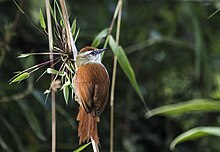| Marcapata spinetail | |
|---|---|

| |
| Conservation status | |
 Least Concern (IUCN 3.1) | |
| Scientific classification | |
| Domain: | Eukaryota |
| Kingdom: | Animalia |
| Phylum: | Chordata |
| Class: | Aves |
| Order: | Passeriformes |
| Family: | Furnariidae |
| Genus: | Cranioleuca |
| Species: | C. marcapatae |
| Binomial name | |
| Cranioleuca marcapatae Zimmer, JT, 1935 | |

| |
The Marcapata spinetail (Cranioleuca marcapatae) is a species of bird in the Furnariinae subfamily of the ovenbird family Furnariidae. It is endemic to Peru.
Taxonomy and systematics
The Marcapata spinetail was first described in 1935 from a specimen probably collected in 1905. It was treated as monotypic until 1984 when what is now the Vilcabamba spinetail (C. weskei) was described as a subspecies of it. BirdLife International's Handbook of the Birds of the World split the Vilcabamba spinetail as a separate species in 2016 and the International Ornithological Committee followed suit in 2023. However, the South American Classification Committee of the American Ornithological Society and the Clements taxonomy retain the two-subspecies treatment of the Marcapata spinetail.
This article follows the monotypic species model.
Description
The Marcapata spinetail is 14.5 to 16 cm (5.7 to 6.3 in) long. The sexes have the same plumage. Adults have a grayish face. Their crown and a short crest are reddish chestnut with black on the sides. Their nape is grayish and their back, tail, and wings are rufous. Their throat is white and their breast and belly are grayish buff. Their iris is reddish brown, their maxilla grayish horn, their mandible silvery to blue-gray, and their legs and feet olive green.
Distribution and habitat
The Marcapata spinetail is found only in southeastern Peru's Department of Cuzco, from the upper Río Urubamba basin east to the valley of the Río Marcapata. It inhabits the understory of humid evergreen montane forest, where it favors areas with thickets of Chusquea bamboo. In elevation it ranges from 2,400 to 3,350 m (7,900 to 11,000 ft).
Behavior
Movement
The Marcapata spinetail is a year-round resident throughout its range.
Feeding
The Marcapata spinetail feeds on arthropods but details are not known. It forages in pairs or in small groups thought to be families, usually as part of a mixed-species feeding flock. It gleans prey from moss, bromeliads, and bark while hitching along limbs. It forages mostly between about 2 and 10 m (7 and 30 ft) of the ground.
Breeding
The Marcapata spinetail's breeding season has not been defined; young of various ages of this species or the Vilcabamba spinetail have been recorded in February, April, May, August, and December. A nest "believed to be of this species" was an oval ball of moss, bark strips, and twigs hanging from a tree limb. Nothing else is known about the species' breeding biology.
|
Songs and calls Listen to Marcapata spinetail on xeno-canto |
Vocalization
The Marcapata spinetail's song is "a thin, descending, accelerating series of high, liquid notes: tew ti-ti-ti'ti'titititi" and its calls include "a high, liquid tew-tik and tewp".
Status
The IUCN has assessed the Marcapata spinetail as being of Least Concern. It has a restricted range and an unknown population size though the latter is believed to be stable. "The only potential threat known to the Marcapata Spinetail is habitat loss, as the species is feared to be susceptible to forest fragmentation and edge effects. However, forests within the range remain largely unaffected by logging, fragmentation and human encroachment." It is considered "uncommon to fairly common".
References
- ^ BirdLife International (2020). "Marcapata Spinetail Cranioleuca marcapatae". IUCN Red List of Threatened Species. 2020: e.T103674421A180871559. doi:10.2305/IUCN.UK.2020-3.RLTS.T103674421A180871559.en. Retrieved 13 November 2023.
- ^ Gill, Frank; Donsker, David; Rasmussen, Pamela, eds. (July 2023). "Ovenbirds, woodcreepers". IOC World Bird List. v 13.2. Retrieved July 31, 2023.
- Zimmer, John T. (1935). "Diagnoses of New Species and Subspecies of Furnariidae from Peru and Other Parts of South America". American Museum Novitates (819): 5. Retrieved November 13, 2023.
- Remsen, J.V. Jr. (1984). "Geographic variation, zoogeography, and possible rapid evolution in some Cranioluca spinetails (Furnariidae) of the Andes". Wilson Bulletin. 96 (4): 515–523.
- HBW and BirdLife International (2022) Handbook of the Birds of the World and BirdLife International digital checklist of the birds of the world. Version 7. Available at: https://datazone.birdlife.org/userfiles/file/Species/Taxonomy/HBW-BirdLife_Checklist_v7_Dec22.zip retrieved December 13, 2022
- Remsen, J. V., Jr., J. I. Areta, E. Bonaccorso, S. Claramunt, G. Del-Rio, A. Jaramillo, D. F. Lane, M. B. Robbins, F. G. Stiles, and K. J. Zimmer. Version 28 September 2023. A classification of the bird species of South America. American Ornithological Society. https://www.museum.lsu.edu/~Remsen/SACCBaseline.htm retrieved October 20, 2023
- Clements, J. F., P.C. Rasmussen, T. S. Schulenberg, M. J. Iliff, T. A. Fredericks, J. A. Gerbracht, D. Lepage, A. Spencer, S. M. Billerman, B. L. Sullivan, and C. L. Wood. 2023. The eBird/Clements checklist of birds of the world: v2023. Downloaded from https://www.birds.cornell.edu/clementschecklist/download/ retrieved October 28, 2023
- ^ Schulenberg, T. S. and T. Johnson (2020). Marcapata Spinetail (Cranioleuca marcapatae), version 1.0. In Birds of the World (T. S. Schulenberg, Editor). Cornell Lab of Ornithology, Ithaca, NY, USA. https://doi.org/10.2173/bow.marspi2.01 retrieved November 13, 2023
- ^ Schulenberg, T. S., D. F. Stotz, D. F. Lane, J. P. O’Neill, and T. A. Parker (2010). Birds of Peru. Revised edition. Princeton University Press, Princeton, NJ, USA
| Taxon identifiers | |
|---|---|
| Cranioleuca marcapatae |
|
